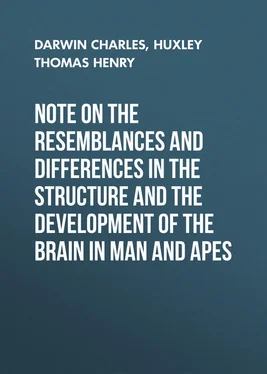Charles Darwin
Note on the Resemblances and Differences in the Structure and the Development of the Brain in Man and Apes
[This essay is taken from 'The Descent of Man and Selection in relation to Sex' by Charles Darwin where it appears at the end of Chapter VII which is also the end of Part I. Footnotes are numbered as they appear in 'The Descent of Man.']
The controversy respecting the nature and the extent of the differences in the structure of the brain in man and the apes, which arose some fifteen years ago, has not yet come to an end, though the subject matter of the dispute is, at present, totally different from what it was formerly. It was originally asserted and re-asserted, with singular pertinacity, that the brain of all the apes, even the highest, differs from that of man, in the absence of such conspicuous structures as the posterior lobes of the cerebral hemispheres, with the posterior cornu of the lateral ventricle and the hippocampus minor, contained in those lobes, which are so obvious in man.
But the truth that the three structures in question are as well developed in apes' as in human brains, or even better; and that it is characteristic of all the Primates (if we exclude the Lemurs) to have these parts well developed, stands at present on as secure a basis as any proposition in comparative anatomy. Moreover, it is admitted by every one of the long series of anatomists who, of late years, have paid special attention to the arrangement of the complicated sulci and gyri which appear upon the surface of the cerebral hemispheres in man and the higher apes, that they are disposed after the very same pattern in him, as in them. Every principal gyrus and sulcus of a chimpanzee's brain is clearly represented in that of a man, so that the terminology which applies to the one answers for the other. On this point there is no difference of opinion. Some years since, Professor Bischoff published a memoir (70. 'Die Grosshirn-Windungen des Menschen;' 'Abhandlungen der K. Bayerischen Akademie,' B. x. 1868.) on the cerebral convolutions of man and apes; and as the purpose of my learned colleague was certainly not to diminish the value of the differences between apes and men in this respect, I am glad to make a citation from him.
"That the apes, and especially the orang, chimpanzee and gorilla, come very close to man in their organisation, much nearer than to any other animal, is a well known fact, disputed by nobody. Looking at the matter from the point of view of organisation alone, no one probably would ever have disputed the view of Linnaeus, that man should be placed, merely as a peculiar species, at the head of the mammalia and of those apes. Both shew, in all their organs, so close an affinity, that the most exact anatomical investigation is needed in order to demonstrate those differences which really exist. So it is with the brains. The brains of man, the orang, the chimpanzee, the gorilla, in spite of all the important differences which they present, come very close to one another" (loc. cit. p. 101).
There remains, then, no dispute as to the resemblance in fundamental characters, between the ape's brain and man's: nor any as to the wonderfully close similarity between the chimpanzee, orang and man, in even the details of the arrangement of the gyri and sulci of the cerebral hemispheres. Nor, turning to the differences between the brains of the highest apes and that of man, is there any serious question as to the nature and extent of these differences. It is admitted that the man's cerebral hemispheres are absolutely and relatively larger than those of the orang and chimpanzee; that his frontal lobes are less excavated by the upward protrusion of the roof of the orbits; that his gyri and sulci are, as a rule, less symmetrically disposed, and present a greater number of secondary plications. And it is admitted that, as a rule, in man, the temporo-occipital or "external perpendicular" fissure, which is usually so strongly marked a feature of the ape's brain is but faintly marked. But it is also clear, that none of these differences constitutes a sharp demarcation between the man's and the ape's brain. In respect to the external perpendicular fissure of Gratiolet, in the human brain for instance, Professor Turner remarks: (71. 'Convolutions of the Human Cerebrum Topographically Considered,' 1866, p. 12.)
"In some brains it appears simply as an indentation of the margin of the hemisphere, but, in others, it extends for some distance more or less transversely outwards. I saw it in the right hemisphere of a female brain pass more than two inches outwards; and on another specimen, also the right hemisphere, it proceeded for four-tenths of an inch outwards, and then extended downwards, as far as the lower margin of the outer surface of the hemisphere. The imperfect definition of this fissure in the majority of human brains, as compared with its remarkable distinctness in the brain of most Quadrumana, is owing to the presence, in the former, of certain superficial, well marked, secondary convolutions which bridge it over and connect the parietal with the occipital lobe. The closer the first of these bridging gyri lies to the longitudinal fissure, the shorter is the external parieto-occipital fissure" (loc. cit. p. 12).
The obliteration of the external perpendicular fissure of Gratiolet, therefore, is not a constant character of the human brain. On the other hand, its full development is not a constant character of the higher ape's brain. For, in the chimpanzee, the more or less extensive obliteration of the external perpendicular sulcus by "bridging convolutions," on one side or the other, has been noted over and over again by Prof. Rolleston, Mr. Marshall, M. Broca and Professor Turner. At the conclusion of a special paper on this subject the latter writes: (72. Notes more especially on the bridging convolutions in the Brain of the Chimpanzee, 'Proceedings of the Royal Society of Edinburgh,' 1865-6.)
Конец ознакомительного фрагмента.
Текст предоставлен ООО «ЛитРес».
Прочитайте эту книгу целиком, купив полную легальную версию на ЛитРес.
Безопасно оплатить книгу можно банковской картой Visa, MasterCard, Maestro, со счета мобильного телефона, с платежного терминала, в салоне МТС или Связной, через PayPal, WebMoney, Яндекс.Деньги, QIWI Кошелек, бонусными картами или другим удобным Вам способом.












